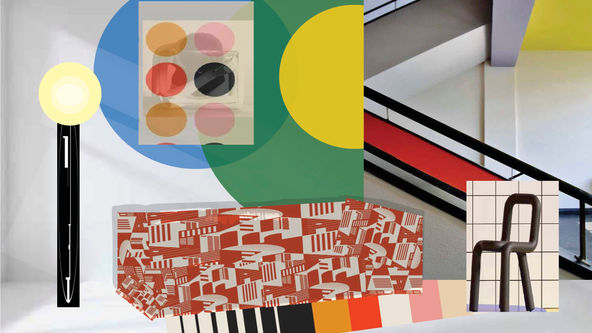Bauhaus Design Style
Emily Varoujanian & Emily Guy


© Emily Varoujanian & Emily Guy

© Emily Varoujanian & Emily Guy

© Emily Varoujanian & Emily Guy

© Emily Varoujanian & Emily Guy
Truth and Honesty In The Form Of Material And Art, Not Relationships.
The Bauhaus Movement took its initial start in 1919 when a school was founded by German architect Walter Gropius with a core objective to reimagine the material world to reflect the unity of all arts. The school was meant to fulfill Gropius’s vision “of bridging the gap between art and industry by combining crafts and fine arts”. His vision was explained in the Proclamation of the Bauhaus that outlined a utopian craft guild that combined architecture, painting, and sculpture into a single creative expression. Being jump started just one year after World War I, the movement was meant to reflect a new period of time where the machine dominated society and the elements of fine arts and design education were blended together. This meant art and design were becoming sleeker while still being functional.
Not only did the movement bridge the gap between art and industry, but it also bridged the gap between design and functionality by using materials in its most appropriate and honest form as opposed to changing them. Because of “truth to materials” being a core tenet, economic sensibility, simplicity, and mass production were able to characterize the Bauhaus style. Students of Bauhaus specialized in workshops that included metalworking, weaving, cabinetmaking, pottery, painting, and typography. Gropius's plan was to unify art while repositioning the goals of the Bauhaus. In 1923, the goals of the movement were shifted to stress the importance of designing for mass production, and the slogan “Art into Industry” was adopted. And so, conventional forms like chairs were often dematerialized to their minimal existence. This upheld the tenet of “truth to materials” by making it so these conventional forms were made in their most honest way and without their innate qualities being hidden. Paintings, architecture, furniture, and textiles created from a wide range of mediums, materials, and disciplines are what make up the style that dominated the 1920s and 1930s. With its unique approach of little ornamentation and focus on balanced forms and abstract shapes, Bauhaus was able to craft and assemble any product while honouring its essential nature. Exposing materials rather than hiding them and clean lines were key to the style. The combination of arts and crafts helped the movement “aim to bring art back into contact with everyday life.” Abstract paintings by artists like Wassily Kandinsky and Paul Klee emphasize functionality throughout the use of balance, and with its unquestionable inspiration from architecture, Bauhaus style paintings pair flat planes to overlapping shapes which suggests dimensionality. This makes the truth to materials come to life because architectural design and inspiration can be seen in these paintings making it feel real and abstract all at once.
Architecture and art are alike in Bauhaus. Architecture is characterized by harmoniously balanced geometric shapes and functionality that feature bold and clean lines. Abstract shapes are also carefully used throughout the interior for decor. Simple color schemes, basic industrial features, balanced asymmetry, and holistic design are also seen in Bauhaus architecture which helped to inspire modern and mid-century modern design. Just like the rest of the style, the truth in architecture is seen in things like unpainted, exposed concrete or even exposed beams and pipes.


